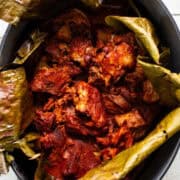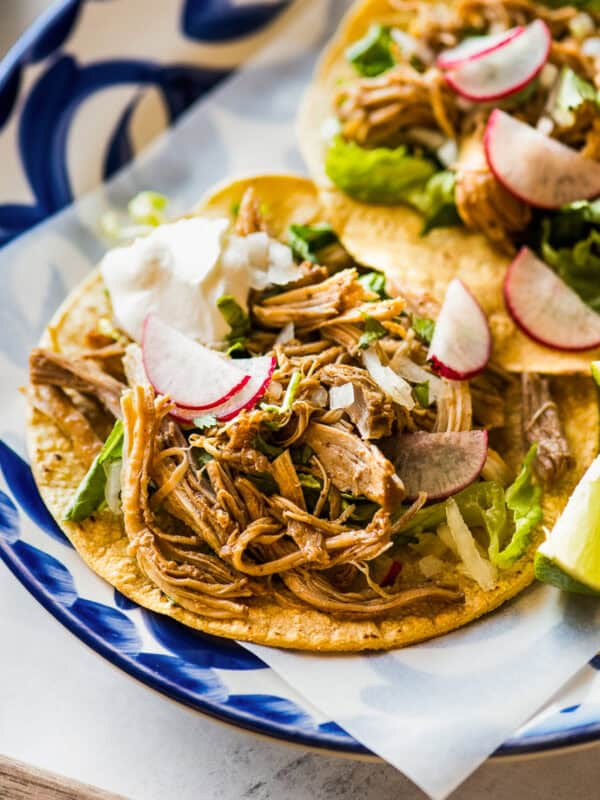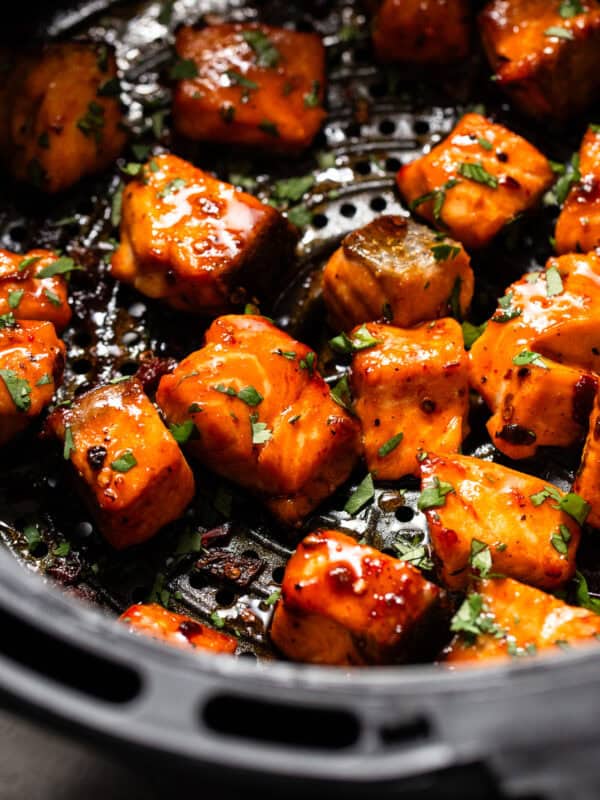This post may contain affiliate links. Please read our disclosure policy.
Cochinita pibil is a traditional Mexican dish featuring tender pork slow-cooked to perfection with a marinade of achiote paste, citrus juices, and a blend of aromatic spices. It’s wrapped in banana leaves and roasted to achieve a melt-in-your-mouth texture, perfect for pairing with fresh corn tortillas, pickled red onions, and spicy salsa!
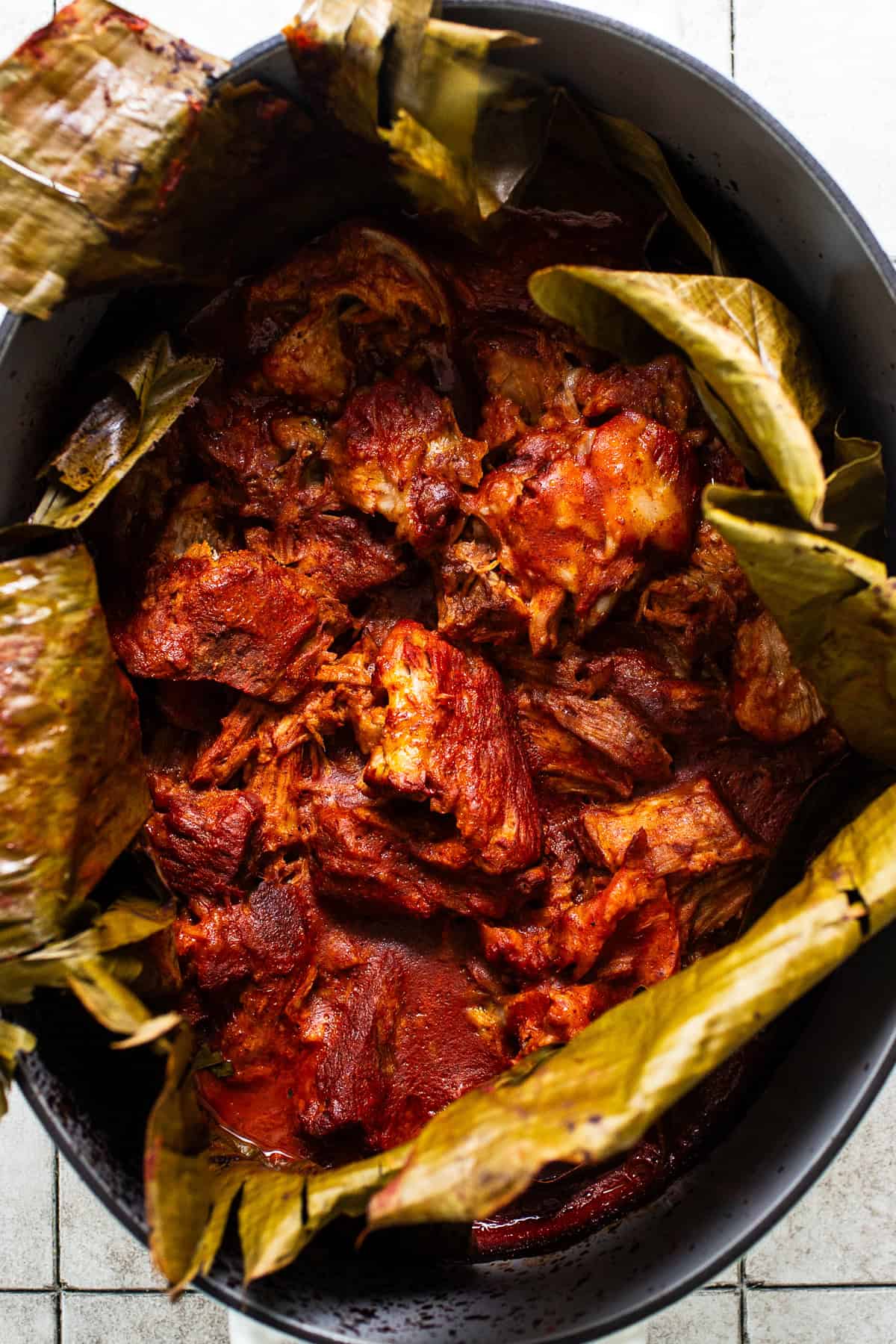
Table of Contents
Cochinita pibil wasn’t something I grew up eating, but it quickly became a favorite. It’s one of those foolproof recipes that requires minimal effort but delivers big on flavor — thanks to a killer marinade and slow roasting (much like my tacos al pastor, carnitas, and barbacoa recipe).
I like to marinate the pork overnight, then let the oven do all the work, resulting in an insanely flavorful meal with almost no hands-on time.
Why You’ll Love This Recipe
- It’s a make-ahead dream. The longer it marinates, the better it gets. Plus, leftovers are amazing.
- The flavor is unreal. The combination of achiote, citrus, and slow-cooked pork is basically magic. It’s the perfect balance of earthy, tangy, and slightly sweet, with so many layers of flavors.
- It’s surprisingly simple. The marinade does all the hard work, and the oven (or slow cooker) takes care of the rest. That’s a win in my book.
What Is Cochinita Pibil?
Cochinita pibil is a classic Mexican dish from the Yucatán Peninsula, known for its bold flavors and rich history. The name roughly translates to “little pig” (cochinita) that’s cooked in a pit (pibil).
Traditionally, the pork is marinated in a mix of achiote and citrus, wrapped in banana leaves, and slow-cooked in an underground oven until it’s melt-in-your-mouth tender. Since most of us don’t have a pit in our backyard, the oven or slow cooker works just as well!
Ingredients You’ll Need
Here’s everything you’ll need to make authentic, flavor-packed cochinita pibil:
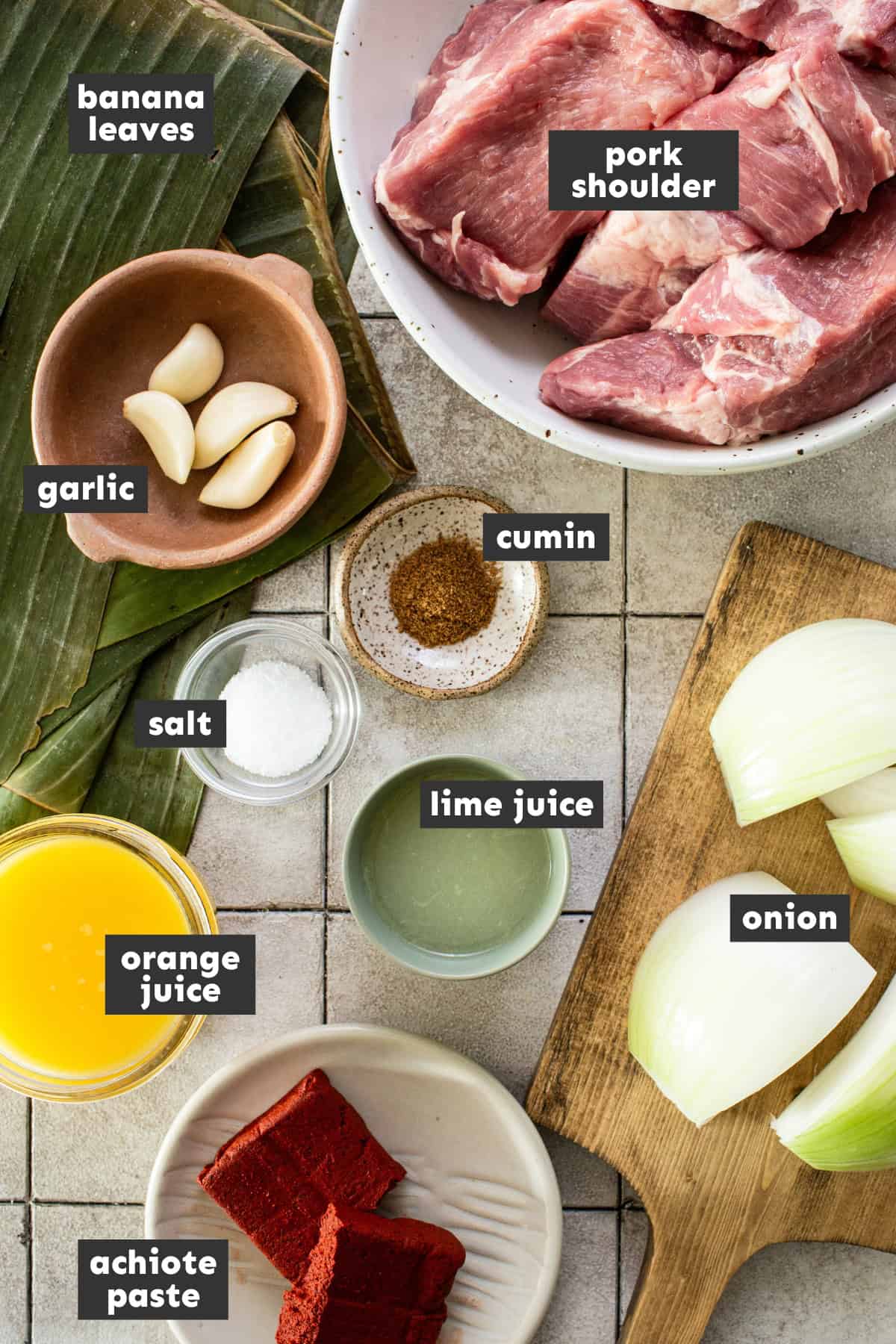
- Achiote paste: This key ingredient gives the dish its signature red-orange color and earthy, peppery flavor. You can find it at most Hispanic grocery stores or in the international section of your local grocery store. You can also find it online.
- Orange and lime juice: The perfect balance of sweetness and citrus not only enhances the flavor but also helps make the pork irresistibly fall apart tender.
- Onion and garlic: Add depth and richness to the marinade.
- Kosher salt and cumin: The achiote paste is packed with spices, so you only need a small amount of kosher salt and cumin to add extra flavor to the marinade.
- Pork shoulder: Also known as pork butt, this cut is marbled with fat, making it perfect for juicy, pull-apart pork.
- Banana leaves (optional): Traditionally used to wrap the pork as it cooks, banana leaves add a subtle sweetness and aroma — but don’t eat them! They’re just for flavor and should be discarded after cooking. If you can’t find any near you, it’s okay. They’re not essential and you can make it without it.
More on Achiote Paste
Achiote paste is a flavorful blend of ground annatto seeds (which give it that vibrant red-orange color), spices, and other seasonings. It’s most commonly used in marinades and stews, like cochinita pibil or pollo pibil.
This ingredient is easy to use, budget-friendly, and widely available — you can find it online, at Mexican grocery stores, or in the international aisle of most supermarkets.
Its unique flavor and texture are hard to replicate, but if you need a substitute, Sazón Goya is the closest option. You can also make your own by grinding annatto seeds with spices for a homemade version.
How to Make Cochinita Pibil
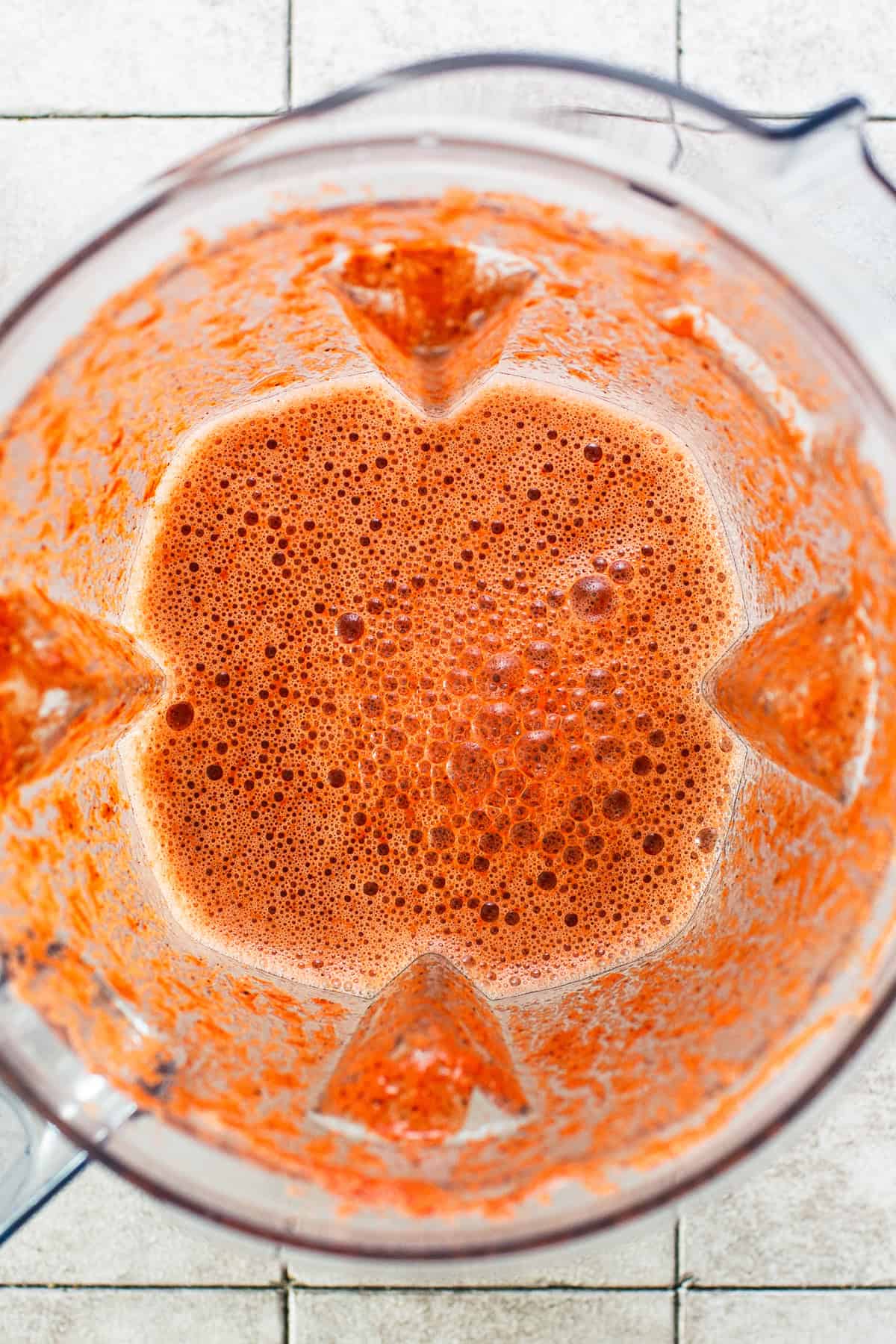
Make the marinade. Blend together the achiote paste, orange juice, lime juice, onion, garlic, salt, and cumin until smooth.
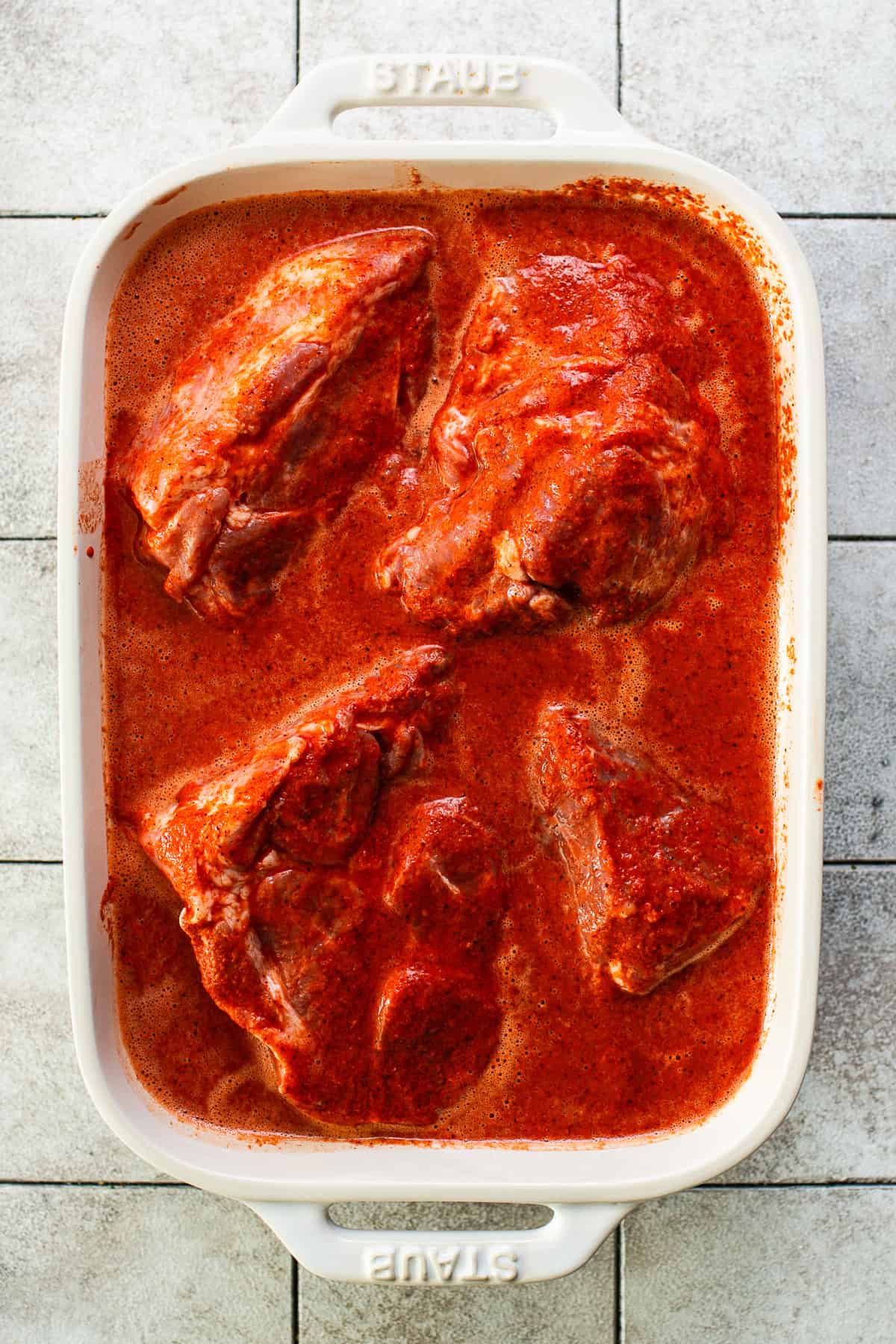
Marinate the pork. Mix the pork shoulder and marinade together in a large bowl until fully coated. Cover with plastic wrap and marinate in the refrigerator for at least 6 hours, and up to 24 hours.
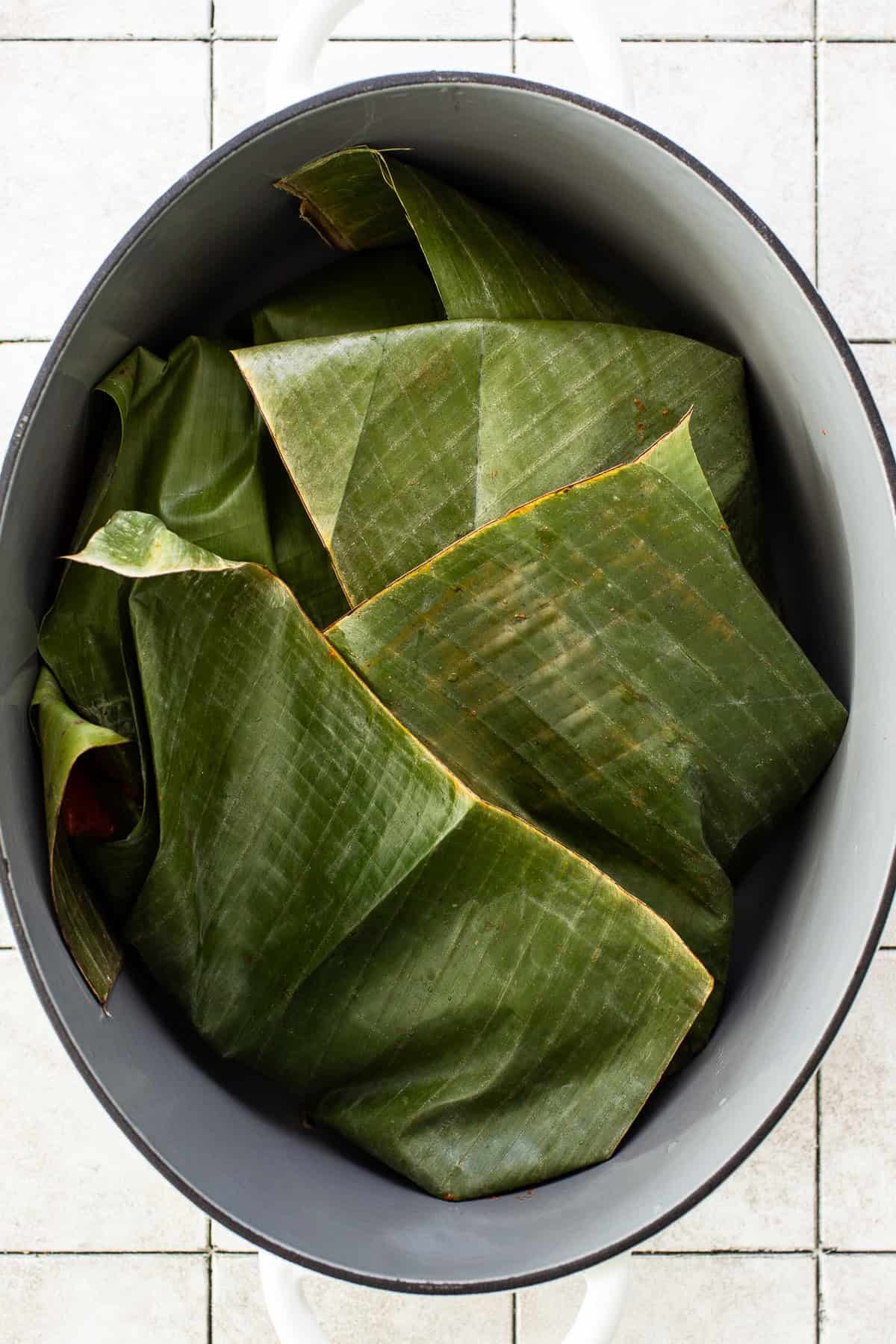
Arrange the banana leaves in a Dutch oven or heavy-bottomed pot so that the bottom is completely covered and the leaves are hanging over the sides. Then add the marinated pork, including all of the juices, into the Dutch oven, and fold in the banana leaves so they completely cover the meat.
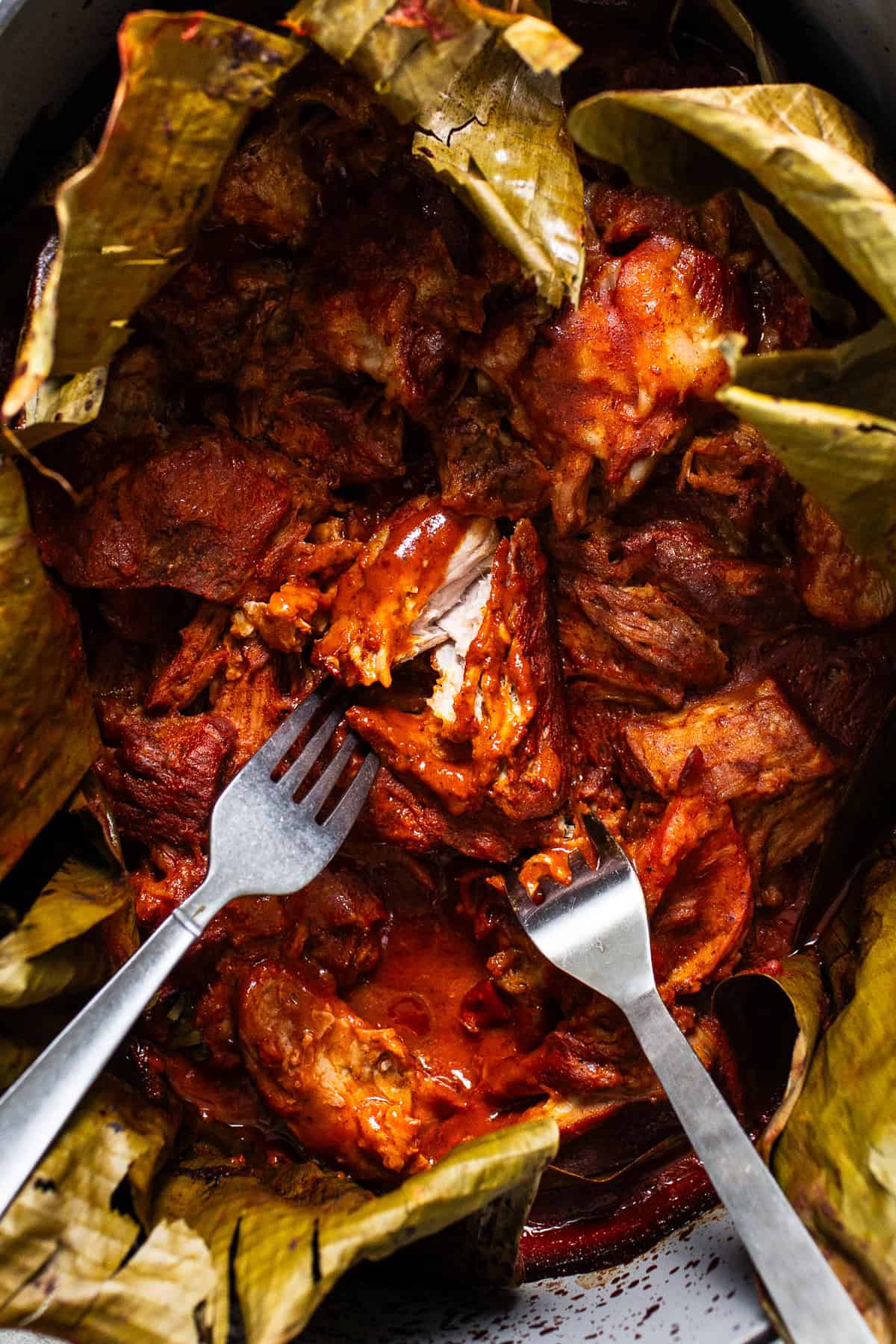
Cover and bake for 3 ½ hours or until the pork is pull-apart tender.
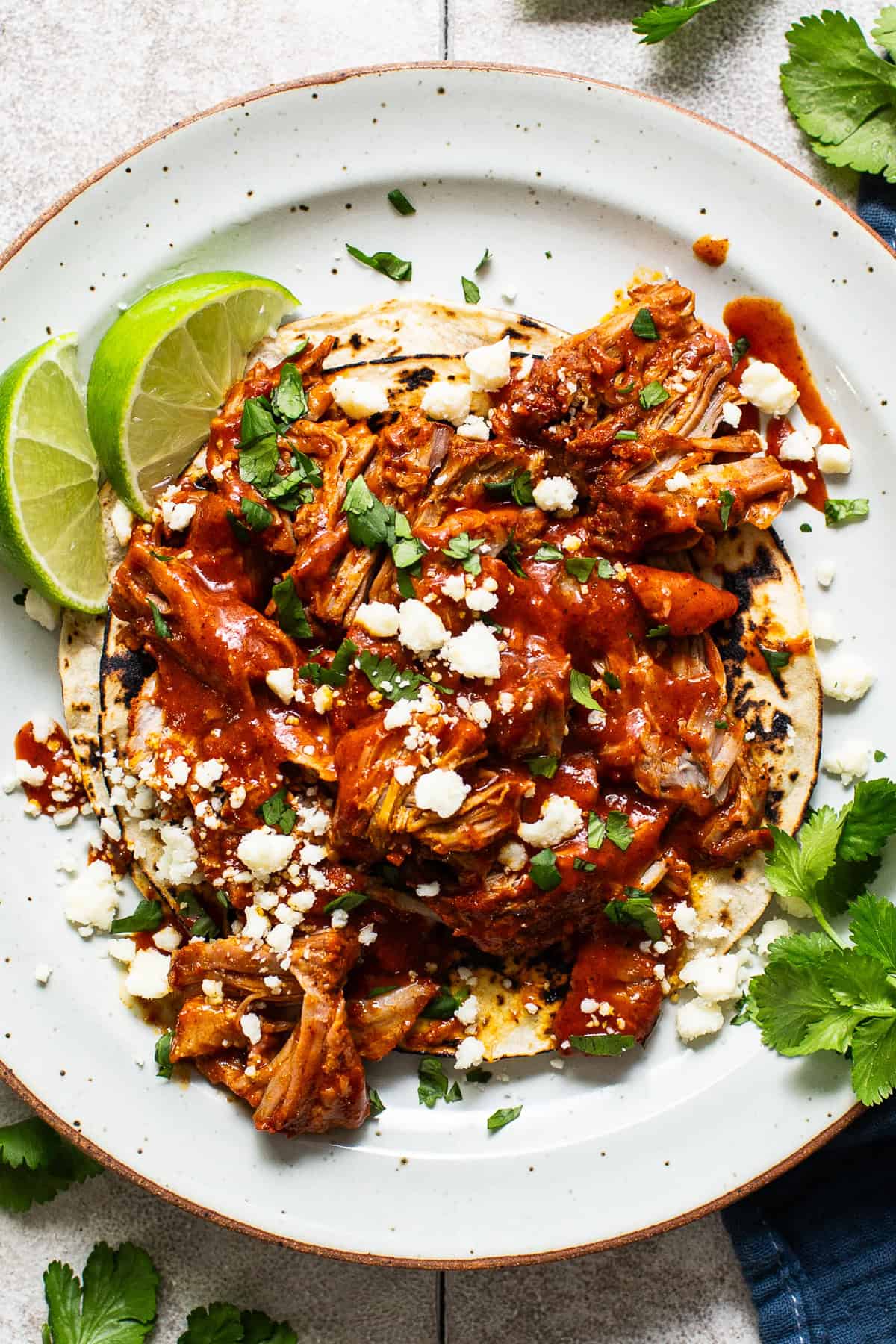
Shred the meat with a fork in a large bowl, add ⅓ cup of the cooking liquid, and serve.
Recipe Tips
- Preparing the banana leaves. You can find banana leaves at most Mexican grocery stores either fresh or frozen. If frozen, make sure to thaw at room temperature until pliable. Wash the banana leaves by wiping with a damp cloth and remove any thick woody stems along the sides.
- Can’t find banana leaves? That’s okay. Though it’s traditionally made with them, they’re not essential. Just omit them and cook as directed.
- Get it a little crispy by pouring extra cooking liquid on top of the shredded pork and broiling on a baking sheet for about 5 minutes (just like in my carnitas recipe).
- Prep ahead of time. The pork can be marinated for up to 24 hours, so feel free to prep this in advance for a delicious dinner.
Slow Cooker and Instant Pot Method
- To make this in the slow cooker, layer the bottom and sides of the slow cooker with banana leaves (if using banana leaves), then add the marinated pork and all of the marinade juices. Fold the excess banana leaves over the top of the pork and top with an additional leaf if needed. Cover and cook on low for 8 hours, or on high for 4-5 hours. Shred and serve as directed.
- To make this in the Instant Pot, add everything to the Instant Pot except the banana leaves. Close the lid of the pressure cooker and move the valve to the sealing position. Press the Manual or Pressure Cook button to high pressure, and cook for 50 minutes. Let the pressure release naturally for 15 minutes, then release the remaining pressure using the vent valve.
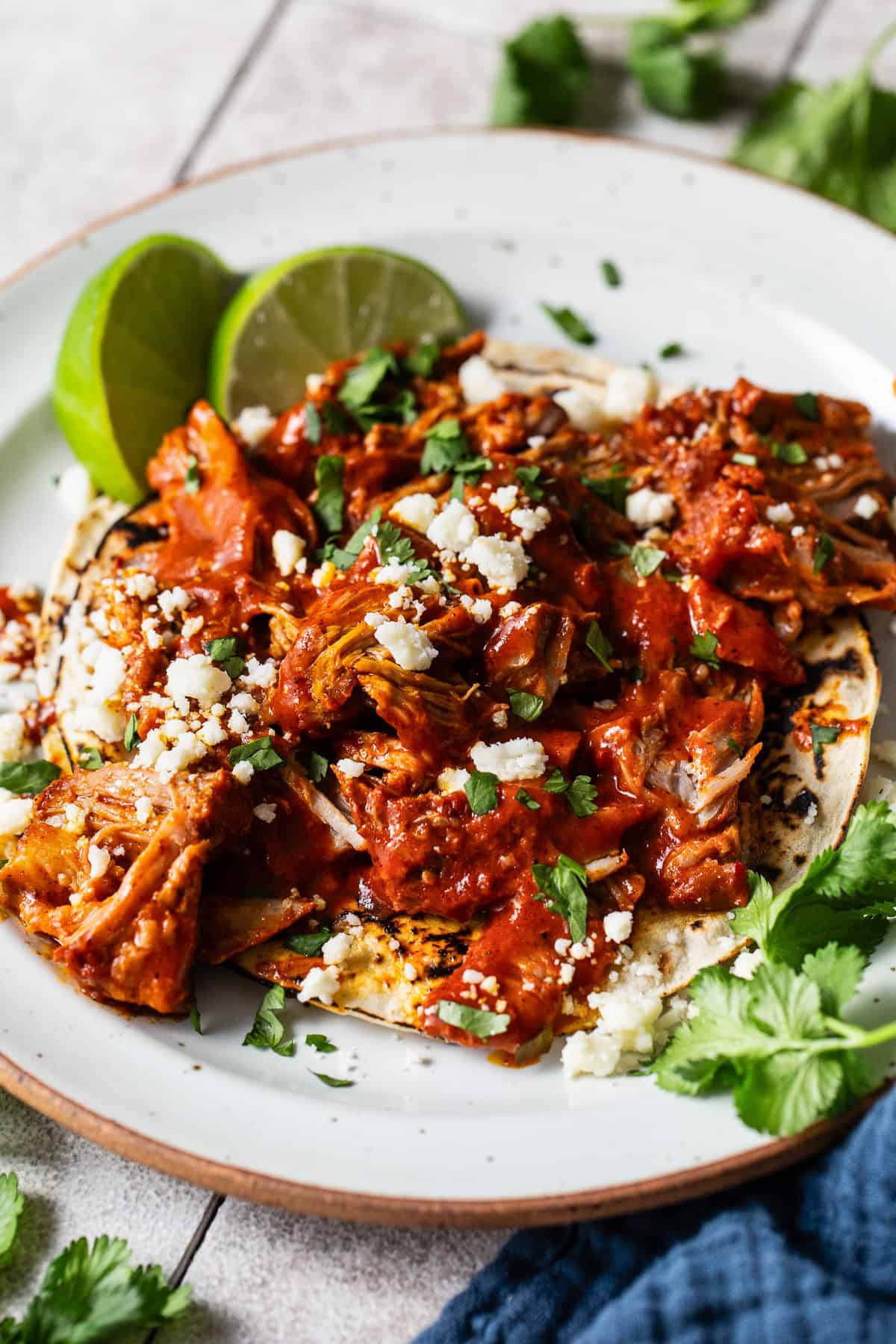
Frequently Asked Questions
No. The achiote gives it a rich, earthy flavor, but there’s no heat. If you want spice, serve it with a spicy salsa or add a couple of serrano peppers or a habanero pepper to the marinade.
Both are slow-cooked pork dishes, but carnitas are typically cooked in their own fat (like confit), resulting in crispy, caramelized edges with a distinctly savory, rich, and salty flavor, whereas cochinita pibil is marinated in achiote and lots of citrus giving it a tangy, earthy, and slightly sweet flavor with no crispiness.
Ways to Serve Cochinita Pibil
- In tacos – Cochinita pibil is traditionally served in warm corn tortillas and topped with pickled red onions, homemade queso fresco, and cilantro.
- On tostadas – Grab some tostada shells and layer it with refried beans (or refried black beans), some shredded cochinita pibil, and diced avocado.
- In rice bowls – Serve the shredded pork over cilantro lime rice or Mexican rice with black beans and some fresh lime juice.
- Make tamales – Cochinita pibil makes a great filling for tamales! Use my masa for tamales recipe, then fill and steam just like you would my red Mexican tamales.
Storing, Freezing, and Reheating
To store or freeze, transfer the shredded pork to an airtight container and refrigerate for up to 5 days or freeze for up to 3 months.
To reheat, warm in a skillet over medium heat until hot or heat in the microwave in 1-minute intervals.
More Mexican Recipes
Did you make this cochinita pibil recipe? Be sure to leave a rating and a comment below! I love hearing about your experience, and it also helps others.
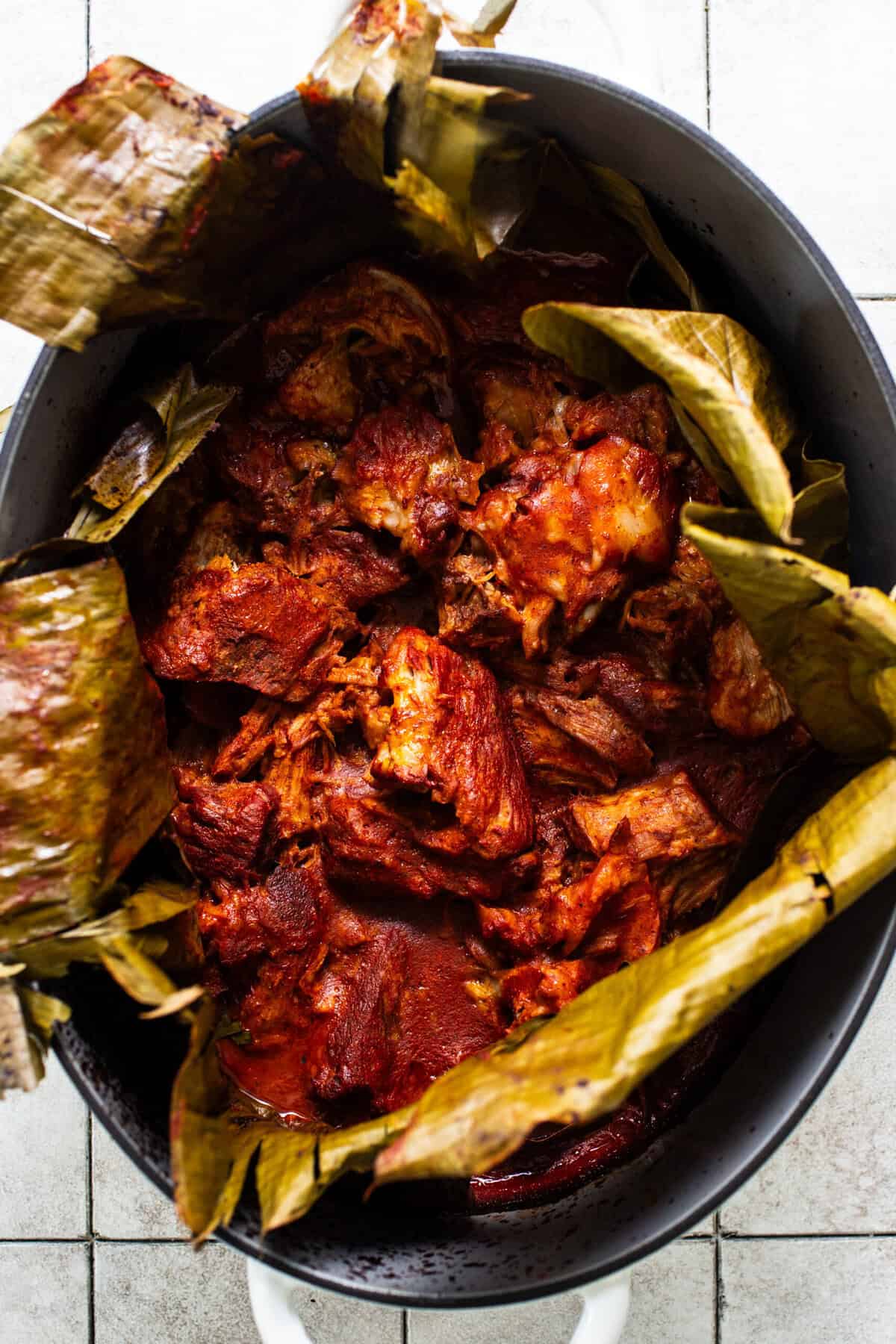
Cochinita Pibil
Ingredients
- 3 ½ ounces achiote paste
- 1 cup orange juice (about 4-5 fresh oranges)
- ½ cup lime juice (about 4 fresh limes)
- 1 white onion, quartered
- 4 cloves garlic
- 1 teaspoon kosher salt
- ½ teaspoon ground cumin
- 3 pounds pork shoulder, cut into large chunks
- 2-3 banana leaves, wiped clean (optional)
- For serving (optional): corn tortillas, pickled red onion, queso fresco, chopped cilantro
Instructions
- Add the achiote paste, orange juice, lime juice, onion, garlic, salt, and cumin to a large blender. Blend until smooth.
- Add the cut pork shoulder to a large bowl or baking dish and pour the blended marinade on top. Toss together until evenly coated. Cover with plastic wrap and marinate in the refrigerator for at least 6 hours, and up to 24 hours.
- Preheat oven to 325℉. Place the banana leaves in a Dutch oven so that the bottom is completely covered and the leaves are hanging over the sides.
- Pour the marinated pork, including all of the marinade juices, into the Dutch oven, then fold in the banana leaves so they completely cover the meat.
- Cover and bake for 3 ½ hours, or until the pork is pull-apart tender. (See Notes for other cooking methods)
- Remove from the oven and transfer the pork into a bowl with a slotted spoon.
- Shred the meat with a fork and add in ⅓ cup of the cooking liquid.
- Serve in tacos with warm corn tortillas, pickled red onion, queso fresco, and chopped cilantro.
Notes
- Banana leaves: Though they are traditionally used, they are not essential to make delicious cochinita pibil at home and are optional. If you can’t find any near you, omit them and make the recipe as directed.
- Slow cooker method: Add everything to a large slow cooker, cover, and cook on low for 8 hours, or on high for 4-5 hours.
- Instant Pot method: Add everything to the Instant Pot, except the banana leaves. Close the lid of the pressure cooker and move the valve to the sealing position. Press the Manual or Pressure Cook button to high pressure, and cook for 50 minutes. Let the pressure release naturally for 15 minutes, then release the remaining pressure using the vent valve.
- Add some crispiness by pouring extra cooking liquid on top of the shredded pork and broiling on a baking sheet for about 5 minutes.
- Prep ahead of time. The pork can be marinated for up to 24 hours, so feel free to prep this in advance for a delicious dinner.
Nutrition
Nutrition information is automatically calculated, so should only be used as an approximation.
Photography by Ashley McLaughlin.

